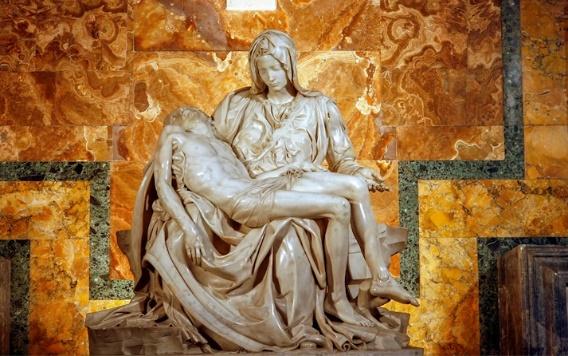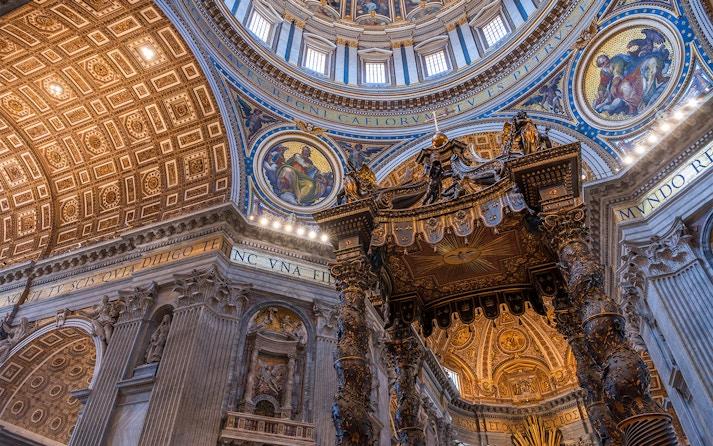Introduction/General Information
Among the world’s most artistically influential and magnificent buildings, St. Peter’s Basilica in Vatican City stands as an unparalleled masterwork, synthesizing multiple artistic disciplines into consecrated spaces designed to inspire spiritual transcendence through sacred works of phenomenal beauty and scale. This seminal Renaissance church’s interiors and grounds showcase legendary triumphs in sculpture, music, and visionary architectural choreography, manifesting divine narratives into transformative experiential phenomena. For this analysis, I have chosen to examine three different art forms used in St. Peter’s Basilica in Vatican City – the visual art of Michelangelo’s Pietà sculpture, the music performed during papal liturgical celebrations, and theatrical elements within the Basilica’s architecture and design.
Visual Art: Pietà by Michelangelo (1499)

(St. Peter’s Basilica Tickets, n.p.)
This renowned Renaissance sculpture depicts the body of Jesus Christ after being crucified and cradled in the arms of his mother, Mary. The life-size marble sculpture is in the first chapel on the right as one enters the Basilica.
Music: Papal Liturgical Celebrations

(Vatican News n.p.)
The Basilica hosts various papal liturgical celebrations, masses, and other events throughout the year where the Sistine Chapel Choir and others perform sacred music. This influential choir has been part of papal celebrations since the 1400s.
Theatre: Architectural Design of St. Peter’s Basilica – The Confessio

(St. Peter’s Basilica Tickets, n.p.)
The grand interior spaces and architectural elements of St. Peter’s Basilica incorporate theatrical concepts through design choices meant to evoke transcendent experiences akin to staging within the church environment.
Brief Description
Visual Art: Pietà
The Pietà portrays the biblical scene of the Virgin Mary cradling Christ’s lifeless body after the crucifixion. Michelangelo’s exquisite detailing and expert carving brought spiritual gravitas to this emotional subject through meticulous naturalism.
Music: Papal Liturgies
The Pietà portrays the biblical scene of the Virgin Mary cradling Christ’s lifeless body after the crucifixion. Michelangelo’s exquisite detailing and expert carving brought spiritual gravitas to this emotional subject through meticulous naturalism. The tender embrace between Mary and Christ’s sculpted figures makes this work one of the most famous and transcendent sculptures ever created.
Theatre: Basilica’s Architecture – The Confessio
The Basilica’s immense scale, famous domes, altars, sculpture, light effects, and overall aesthetic choreography align to create a theatrical environment highlighting critical religious narratives like the life of Christ through experiential architectural storytelling. Such a composition by the artist elevates the dignity of the work (Fichner-Rathus 188). The Confessio area beneath the main altar dramatically focuses attention on the site believed to be the burial place of St. Peter.
Analysis
Visual Art: Pietà
In this incomparable sculpture, Michelangelo revolutionized the conventional Pietà artworks of his era by depicting Christ’s body with phenomenally lifelike musculature and serenity rather than anguish on his face. Michelangelo imbued the marble figures with timeless grace, transcending the weighty narrative of Christ’s torment and death. The tender juxtaposition of Mary’s restrained sorrow cradling Christ’s seemingly peaceful repose distills the biblical events into a wrenching emotional essence. Every curve and fold of drapery exhibits Michelangelo’s staggering ability to render naturalism through his mastery of human anatomy and delicate detailing that marvelously animates the figures. The artistic use in Catholic churches contrasts with the limited use of creative elements in the American protestant church (Todd 13). This resonates with the biblical, “See, the Lord hath called by name Bezaleel the son of Uri….. Hem hath he filled with wisdom of heart, to work all manner of work, the engraver, the cunning workman, and the embroiderer…..” (Exodus 35:30-35 KJV).
Music: Papal Liturgies
Musical performances were pivotal in shaping the sacred environments and dramatic narratives unfolding during papal liturgies at St. Peter’s Basilica over the centuries. The angelic vocals of the Sistine Chapel Choir, elevated by the consecrated acoustics and interiors, fostered an ethereal atmosphere reflective of divine splendors. Hallowed choral masterworks by Palestrina, Allegri, and Anerio served as aural halos, illuminating the biblical texts, rites, and rituals at the heart of Catholic spirituality and adoration of Jesus Christ. The interweaving vocal lines contrapuntally narrating the scriptural episodes created transcendent soundscapes, allowing liturgical celebrations to resonate on mystical, celestial planes.
Theatre: Basilica’s Architecture
Although the main altar and the famous dome attract most visitors’ attention, below it in the Confessio area, there is one of the most dramatic and symbolically loaded spaces in the entire St. Peter’s Basilica, which serves as a testament to its pioneering architectural achievements. In this underground area with railings on all sides, the viewers are led to the central object of attention – a small shrine that is supposed to mark the burial site of Saint Peter himself. Sculptor Gian Lorenzo Bernini’s ornate, towering bronze canopy hovers over the plain facade of the Shrine, with the monumental sculptural element framing and highlighting the all-important religious site. The interior is a theatrical vignette of twisted columns and gilded embellishments in which Peter and his apostles are revered as relics of Christ. The Confessio’s stepped spaces enable the viewers to look down at the pilgrims who, kneeling with fervor, approach the Shrine, unfolding a theatrical choreographed experience with all the watchers concentrating all their eyes on Christianity’s symbolic foundation. The underground chamber is designed to intensify the spiritual drama through visual choreography and artistic storytelling.
Conclusion
St. Peter’s Basilica is one of the landmarks of architecture, synthesizing visual arts, music, and theatrical architectural staging into immersive consecrated environments, inevitably stirring up transcendent experiences that lead to religious devotion and spiritual awakening. With sculptures, choral compositions, and revolutionary Renaissance architectural designs, divine inspirations were transferred to earthly realms. Michelangelo’s Pietà operates on both an intimate and operatic scale – portraying the emotional and symbolic narrative of Christ’s death while also demonstrating a mastery of sculpting spiritual beauty from lifeless substances like marble. The classic shows the characters in an empathetic and poignant manner. Likewise, the angelic sacred music that resonates through the Basilica’s sanctified halls creates celestial harmonies and texts into sublime artistic manifestations of mystical Christian dogmas. The sonic cathedrals erected by composers and vocal ensembles are the ones that either the worshiping congregants or the casual visitors listen to, and through these, manifest the divine splendor in the brief moments.
However, the church’s architectural masterpieces that are scripturally choreographed provide an aesthetic narrative that invites visitors to walk the pilgrimage route through consecrated aesthetic landscapes. While building its traditions on time-honored ecclesiastic archetypes and biblical inspirations, St. Peter’s implemented avant-garde innovations into visual storytelling cycles and perspectival revelations and elevated architectural footprints to immersive experiential stagings. The Confessio epitomizes Bernini’s theatrical, architectural approach, where he frames the symbolic remains of St. Peter through his towering canopy altar sculpture while kneeling pilgrims below form living tableaus under heavenly domes and shafted Lighting. Every individual visual element fuses and transforms into theatrical staging; thus, the visitors are walking performers who are touring awe-inspiring aesthetic phenomena that represent the divine grandeur through material form. The multidisciplinary art triumphs at St. Peter’s Basilica, which combines divine revelations into invigorating emotional and sensory human experiences, showing the eternal interconnection of artistic creativity. The Basilica illustrates that creativity is the most crucial method for worshiping God, having sudden revelations, and having everlasting faith across cultures and generations.
Works Cited
“Saint Peter’s Basilica preparing for 2025 Jubilee Year.” Vatican News, 8 Mar. 2022, https://www.vaticannews.va/en/vatican-city/news/2022-03/saint-peter-s-basilica-preparing-for-2025-jubilee.html. Accessed 20 Mar. 2023.
Fichner-Rathus, L. Understanding Art. 10th Edition. Cengage Learning. 2012.
Smith, Todd. A Creative Church: The Arts & A Century of Renewal. 1st Edition. Kendall Hunt Publishing. 2015.
St. Peter’s Basilica Tickets. “Michelangelo’s Pieta.” St. Peters Basilica Tickets, https://www.st-peters-basilica-tickets.com/inside-st-peters-basilica/. Accessed 20 Mar. 2023.
St. Peter’s Basilica Tickets. “The Confessio.” St. Peters Basilica Tickets, https://www.st-peters-basilica-tickets.com/inside-st-peters-basilica/. Accessed 20 Mar. 2023.
The Bible. Authorized King James Version, Oxford UP, 1998.
 write
write